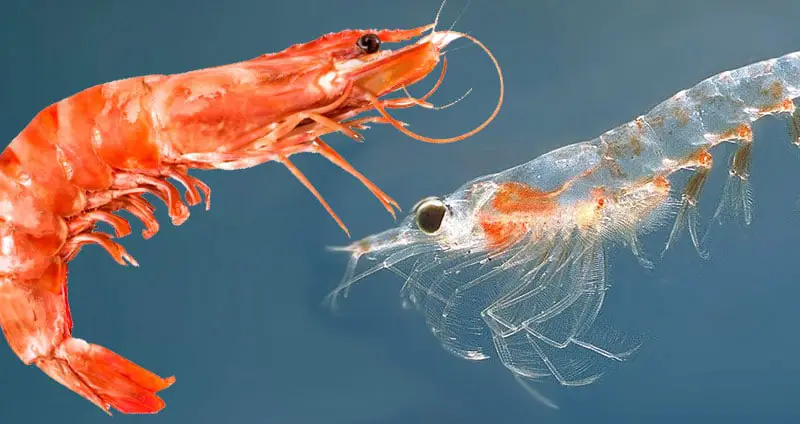You may think to yourself that there’s a big difference between shrimp and krill. After all, we eat shrimp, we don’t eat krill.
But there are certain features that make it easy to distinguish between the two species. For example, shrimp only live a year or two, but during that time, they lay nearly a million eggs.
Krill may be much tinier than shrimp, but they can live up to 10 years. In that time, krill lay an average of a thousand eggs per year.
There are even more interesting differences between them. So let’s dive and start comparing shrimp vs krill.
Table of Contents
Comparing Shrimp and Krill
When talking about shrimp vs krill, the first feature we think about is how they move.
Despite the fact that shrimp have tiny brains, they’re excellent swimmers and can quickly maneuver backward and forwards. Krill can also swim forward and backward, but they’re not as quick as shrimp.
Here are some more points where they differ.
Appearance
Both types of crustaceans have a hard exoskeleton, so they’re a part of the arthropod family, which make up three-fourths of all animals. This outer covering protects their vital organs and inner tissues.
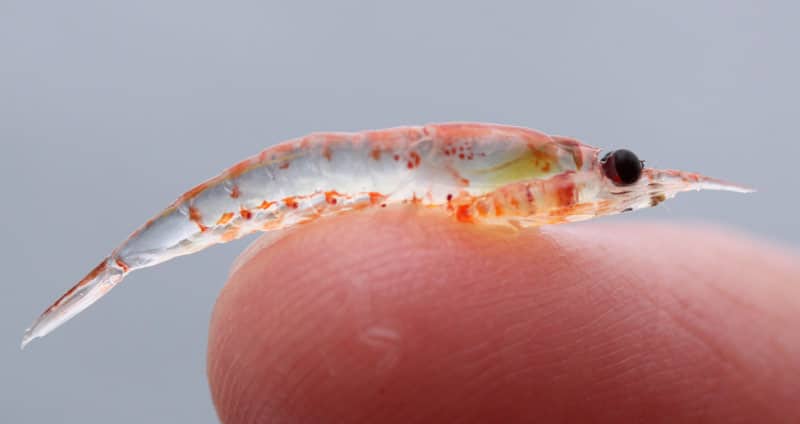
Shrimp
Shrimp is part of the crustacean family. Their bodies are divided into two parts: the cephalothorax and the abdomen. Their heads and vital organs are covered with the carapace, which is the protective hard shell-like covering.
Shrimp have 10 legs, making them part of the ‘decapod’ group of crustaceans, such as lobsters. They’re known for their somewhat long abdomen which has five pairs of swimmerets, a pair of uropods, and a tailpiece. Shrimp have double tails similar to that of fish.
Uropods are posterior appendages. They act as rudders and help the shrimp steer as it moves forward and backward.
Shrimp have two pairs of antennae and are known for their wide variety of colorful external covering. lifespan is about two years. They can grow from 1 inch to 12 inches long.
There are over 1900 species of shrimp. Another interesting feature about shrimp is that they have one pair of jaws and five pairs of accessory jaws. These extra jaws allow shrimp to swim, grasp food, and bite into it.
Krill
Krill is much smaller than shrimp, even though it’s still part of the crustacean family. It’s made up of three main parts: the head, also known as the cephalon, the thorax, and the abdomen. The last two parts are covered with a protective shell, called the carapace.
Krill have one pair of antennae. The number of legs depends on the species. But all 85 species of krill have five pairs of swimming legs called ‘swimmerets’. Their length can range from ½ an inch to 6 inches long. Krill are mostly transparent. But some may have pigment spots that give them a red hue. They can live up to ten years.
Diet
Both shrimp and krill are known to be scavengers, feeding mainly on detritus.
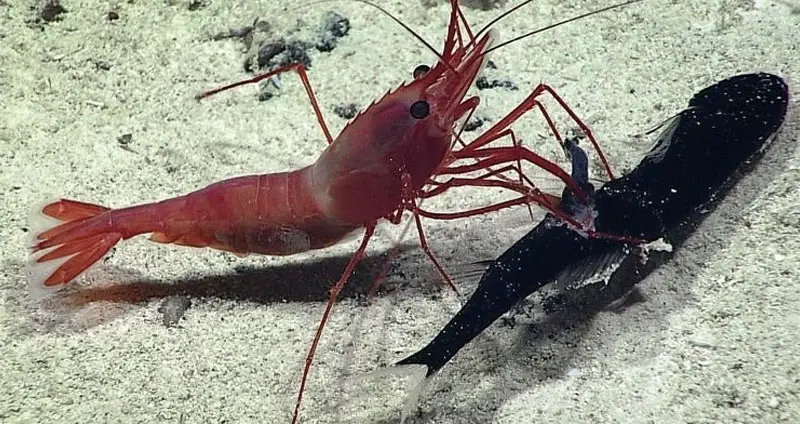
Shrimp
Shrimp eat almost anything they come across. They‘re mostly omnivores. Their main prey is algae and plankton, along with tiny fish. One species of shrimp is known to make a snapping sound with its claws. This sound travels through the water and stuns their prey.
Krill
Krill are herbivores. Their main source of food is phytoplankton. They also eat algae and zooplankton. They gather their food by filtering the water with their front legs. Interestingly, their front legs collect the food as it drifts by in the water.
Habitat
Being easy prey, both types of crustaceans can usually be found near the ocean floor or seabed.
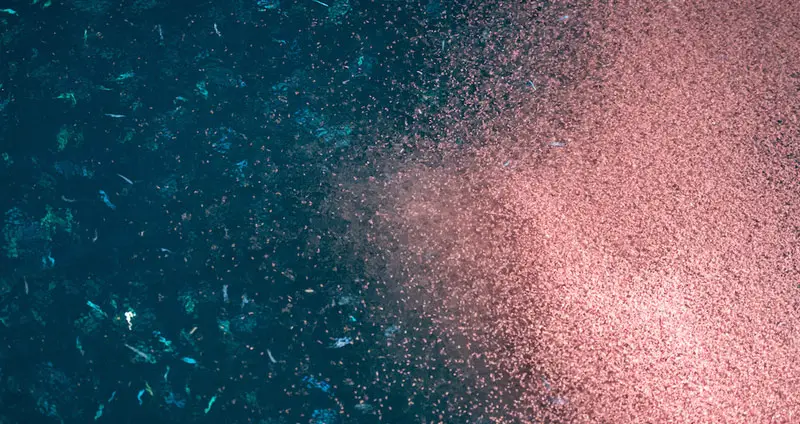
Shrimp
Shrimp can be found mostly looking for food on the ocean floor. They also use a filter system to ingest small plant and animal particles as they’re swimming through the water. But they don’t get to the surface very often.
Krill
Krill is usually found on the seabed. This allows them to stay hidden and protected from predators. When they look for food, they head near the ocean surface, often in massive groups. That’s where most of the single-celled plants, or phytoplankton, are.
Behavior
Being small and largely defenseless, both shrimp and krill forage for food, then stay dormant most of the day as a way of avoiding predators.
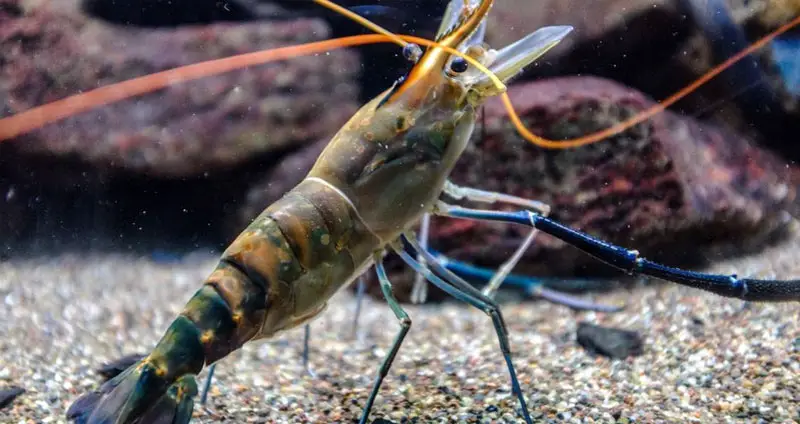
Shrimp
Shrimp are almost always near the seabed. It’s where they find food easily, and stay protected from large marine animals.
Even though they’re small, shrimp have a well-known and unique characteristic. They’re capable of picking off parasites and fungi from marine animals.
Some shrimp species are called ‘cleaner shrimps’ exactly for this reason. There are shrimp that live on various types of fish, starfish and sea urchins, and provide a cleaning service. In return, they’re protected by these animals and kept safe from predators.
Krill
Did you know that the oldest known krill ancestors date back to 130 million years ago?
Krill can be found in large masses known as swarms. These tiny invertebrates have gills that help them breathe by drawing out oxygen from the water.
Another interesting feature is that krill can give out light from their bodies. They do this with the help of the organ known as photophores.
Food Uses/Benefits
Both of these creatures have dietary benefits for both the aquatic animals that eat them and humans. Shrimp are obviously the more commonly-eaten of the two, but krill isn’t untouched by humans.
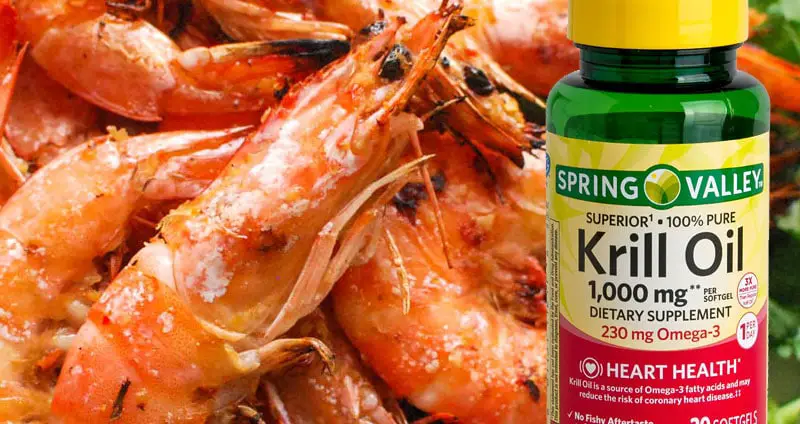
Shrimp
The kind of shrimp we eat is known as opossum shrimp. It can be baked, cooked, fried, or grilled. Shrimp is delicious and nutritious.
Shrimps are low in calories and rich in protein, omega-3 fatty acids, and a number of antioxidants. They also contain vitamins and minerals, such as vitamin B12, phosphorous, copper, and selenium.
Krill
Krill has high levels of omega-3 fatty acids. This led some pharmaceutical companies in Canada and Norway to market krill health pills for their nutritional benefits.
Krill is also being harvested in hospitals and chemical labs. It’s used by surgeons to clean wounds. It’s also been proven to be a safe contact cleaning solution.
Threats
Marine life, in general, is facing great danger due to pollution and climate change. Sadly, the first to face this threat are the smaller species.
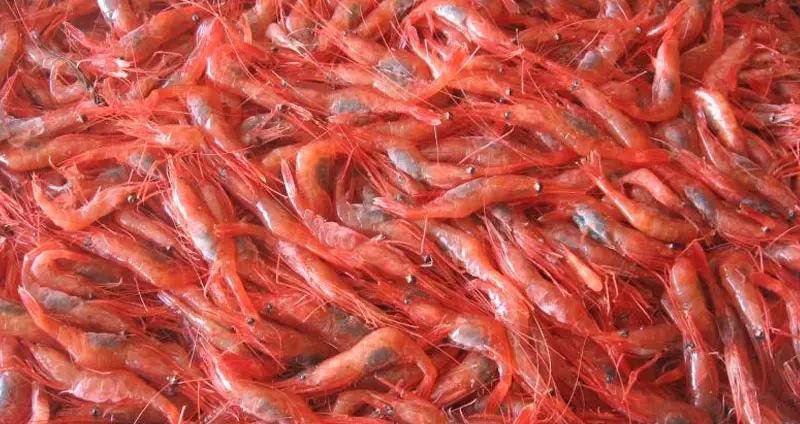
Shrimp
The main threat that faces shrimp isn’t from marine predators, it’s from overfishing. They get caught in nets meant for fish and can’t swim back out.
Other factors that pose a threat to shrimps, causing their numbers to decrease is water pollution, oil spills, and drilling. Another major factor is the huge amount of ice melting in the Antarctic region due to climate change. Research shows it’s melting at a rate of 12.85% every ten years.
Krill
Krill is considered to be the main food source of whales, dolphins, sea birds, penguins, and many other types of marine animals. These predators consume about 55 million tons of krill per year.
However, the number of krill is greatly declining mainly in the Antarctic because glaciers are melting. This drastic loss of ice is killing off the main food source of krill, ice algae. Studies carried out in 2004 show that the number of krill has dropped to a mere fifth of what it was thirty years earlier back in 1974.
This can have a direct impact on all the different types of marine animals that depend on krill as a main food source. If the number of krill starts to decline, so can the many types of marine life in our oceans.
Conclusion
Comparing shrimp vs krill shows us how different these tiny creatures are. They possess a few similar traits, but overall, their differences is what makes them special.
However, one thing we all agree on is how important they are to the food chain. They’re amazing, tiny creatures that help maintain the delicate balance of our ecosystem.

